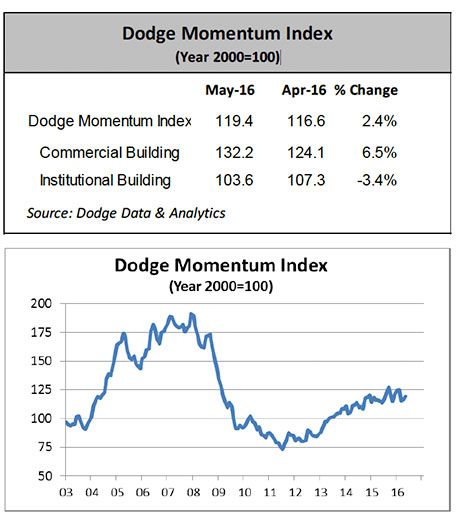Economy Watch: Nonresidential Construction Still Has Momentum
May’s increase in nonresidential building projects suggests further growth in construction activity in 2016 despite first-quarter market volatility.
By Dees Stribling, Contributing Editor

Credit: Dodge Data & Analytics, Dodge Momentum Index, May 2016
The Dodge Momentum Index rose 2.4 percent in May to 119.4 from its revised April reading of 116.6 (2000 = 100). The index, published by construction industry data specialist Dodge Data & Analytics, is a monthly measure of the first (or initial) report for nonresidential building projects in planning, which leads construction spending for nonresidential buildings by a full year.
The increase for the index in May was due to a 6.5 percent gain for projects entering planning in the commercial sector, which more than offset a 3.4 percent decline for such projects in the institutional sector. May’s increase places the overall index 3.6 percent higher than a year ago, suggesting further growth in construction activity in 2016 despite the subdued first-quarter GDP and lending standards that are beginning to tighten for commercial projects.
The commercial portion of the index rose in May for the second consecutive month and is at its highest level since September 2015. This recent improvement for commercial projects provides some evidence that construction plans are moving forward after the severe drop-off that occurred with financial market instability in late 2015. At the same time, institutional planning is 1.3 percent lower than it was in May 2015, settling back for now from the heightened activity of late 2015 and early 2016.
In May, Dodge reported, six projects nationwide entered planning with a value that exceeded $100 million. In the commercial building sector, the leading projects were two warehouses in Staten Island–one valued at $304 million and one at $141 million. For the institutional building sector, the leading project was a $252 million neuroscience building at Stanford University in Palo Alto, Calif.







You must be logged in to post a comment.